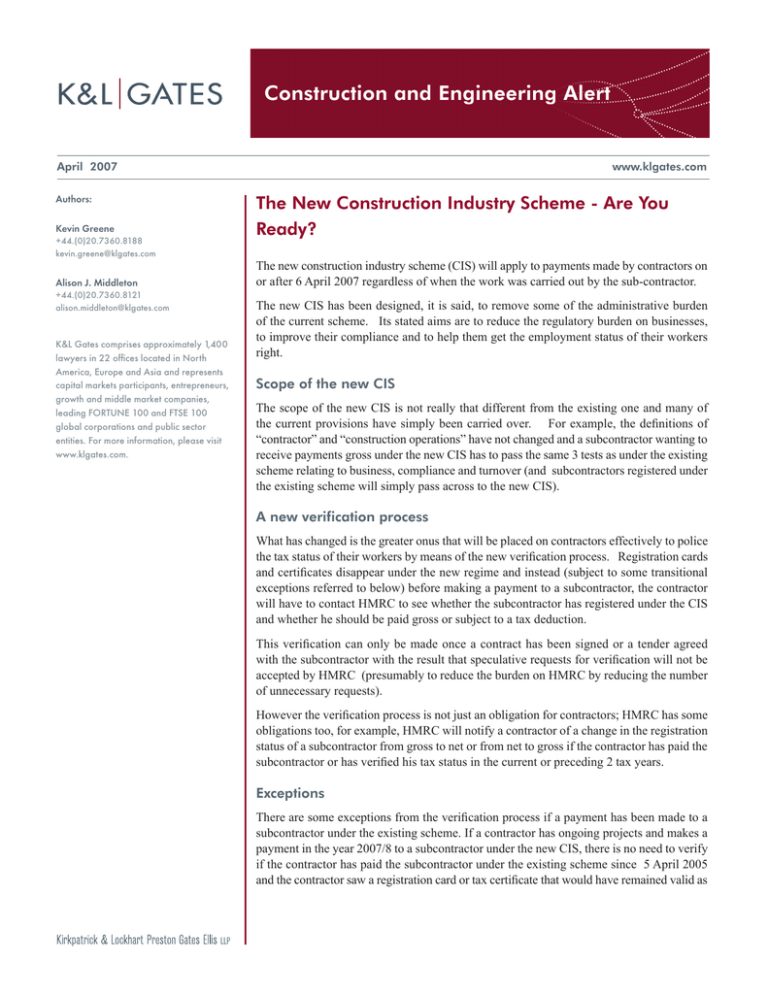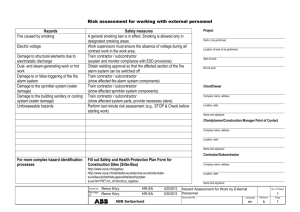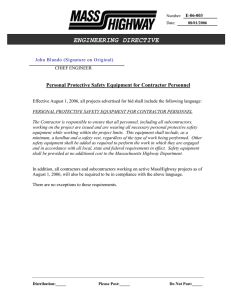
Construction and Engineering Alert
April 2007
Authors:
Kevin Greene
+44.(0)20.7360.8188
kevin.greene@klgates.com
Alison J. Middleton
+44.(0)20.7360.8121
alison.middleton@klgates.com
K&L Gates comprises approximately 1,400
lawyers in 22 offices located in North
America, Europe and Asia and represents
capital markets participants, entrepreneurs,
growth and middle market companies,
leading FORTUNE 100 and FTSE 100
global corporations and public sector
entities. For more information, please visit
www.klgates.com.
www.klgates.com
The New Construction Industry Scheme - Are You
Ready?
The new construction industry scheme (CIS) will apply to payments made by contractors on
or after 6 April 2007 regardless of when the work was carried out by the sub-contractor.
The new CIS has been designed, it is said, to remove some of the administrative burden
of the current scheme. Its stated aims are to reduce the regulatory burden on businesses,
to improve their compliance and to help them get the employment status of their workers
right.
Scope of the new CIS
The scope of the new CIS is not really that different from the existing one and many of
the current provisions have simply been carried over. For example, the definitions of
“contractor” and “construction operations” have not changed and a subcontractor wanting to
receive payments gross under the new CIS has to pass the same 3 tests as under the existing
scheme relating to business, compliance and turnover (and subcontractors registered under
the existing scheme will simply pass across to the new CIS).
A new verification process
What has changed is the greater onus that will be placed on contractors effectively to police
the tax status of their workers by means of the new verification process. Registration cards
and certificates disappear under the new regime and instead (subject to some transitional
exceptions referred to below) before making a payment to a subcontractor, the contractor
will have to contact HMRC to see whether the subcontractor has registered under the CIS
and whether he should be paid gross or subject to a tax deduction.
This verification can only be made once a contract has been signed or a tender agreed
with the subcontractor with the result that speculative requests for verification will not be
accepted by HMRC (presumably to reduce the burden on HMRC by reducing the number
of unnecessary requests).
However the verification process is not just an obligation for contractors; HMRC has some
obligations too, for example, HMRC will notify a contractor of a change in the registration
status of a subcontractor from gross to net or from net to gross if the contractor has paid the
subcontractor or has verified his tax status in the current or preceding 2 tax years.
Exceptions
There are some exceptions from the verification process if a payment has been made to a
subcontractor under the existing scheme. If a contractor has ongoing projects and makes a
payment in the year 2007/8 to a subcontractor under the new CIS, there is no need to verify
if the contractor has paid the subcontractor under the existing scheme since 5 April 2005
and the contractor saw a registration card or tax certificate that would have remained valid as
Construction and Engineering Alert
at 6 April 2007. In those circumstance the contractor
can assume that the status of the subcontractor has
not changed (unless otherwise notified by HMRC).
However if the registration card or certificate expired
before 6 April 2007, the contractor cannot make
that assumption and has to verify the status of the
subcontractor before payment is made under the new
CIS.
Whilst verification will answer the question of whether
to pay net or gross, it does not deal with the problem
of whether the verification has actually been made in
respect of the correct subcontractor. Identity theft
could be a big problem under the new scheme. Unless
the contractor knows the subcontractor personally,
the contractor has to trust that the information given
by the subcontractor for verification is the right
information. The contractor will need to know the
subcontractor’s name, unique taxpayer’s reference
and national insurance number/company registration
number. Perhaps contractors should also be asking
subcontractors to provide photographic ID such as a
passport or possibly the subcontractor’s letter from
HMRC confirming its registration under the new CIS,
as proof of identity for the verification.
The new verification system is clearly helpful for
subcontractors who will no longer have to travel to
present documents to a contractor before a payment is
made. It will also benefit contractors who no longer
have to worry about expiry dates of certificates or
cards. But contractors will still face the undeniable
burden of the verification process which will of course
depend in turn on the efficiency of HMRC.
verification, so improving overall compliance
levels in the construction industry. But it
effectively shifts the risk of non-compliance by
subcontractors from HMRC to contractors who
have to operate the deduction;
n
n
n
n
Other changes
Other differences from the existing scheme include:
n
a new higher deduction rate of 30% for those
subcontractors who do not meet the tests for
gross payment and those subcontractors who
are not registered with HMRC at all (or whose
details used for verification do not match those
held by HMRC). This higher rate is clearly
an incentive to register under the scheme
and to give contractors the correct details for
n
n
the replacement of vouchers with a
statement to be given by a contractor to each
subcontractor if a tax deduction has been made
(the statements can be made monthly or at the
time when the payment is made, with penalties
applying for failure to provide);
the replacement of end of year returns with
monthly returns which have to be made by a
contractor showing payments (net and gross)
made to all subcontractors in the month.
Penalties apply for failure to submit these
returns based on the length of delay and the
number of subcontractors covered by each
return, as well as for incorrect or incomplete
returns;
the inclusion of a status declaration in the
monthly return confirming that none of those
paid by the contractor is an employee (since
PAYE and NICs would then apply);
the removal of the payment of a reverse
premium from the scope of the new CIS,
so that landlords or developers offering
inducements to prospective tenants such as
payment of fit out costs should no longer have
to worry about the scheme;
an exemption for a non-construction business
which is deemed to be a contractor (because
its average annual spend on construction over
3 years is over £1m) in respect of payments
which relate to a property used for its business
(unless the property is for sale or is let or is
held as an investment);
and record keeping obligations for three years.
April 2007 | 2
Construction and Engineering Alert
Practical matters
Urgent action is needed by contractors, if not already
taken, to ensure that they have in place a robust system
for sending the monthly returns to HMRC on time (to
avoid penalties but also to avoid loss of gross payment
status for failure of the compliance test if the contractor
is also registered under the new CIS as a subcontractor).
They should also consider implementing a system to
ensure that the employment status of all workers is
thought about (so that the status declaration on the
monthly return can be properly signed and cannot be
said to be incorrect) as well as a system for monitoring
and keeping records of all verifications made.
K&L Gates comprises multiple affiliated partnerships: a limited liability partnership with the full name Kirkpatrick & Lockhart Preston Gates Ellis LLP qualified
in Delaware and maintaining offices throughout the U.S., in Berlin, and in Beijing (Kirkpatrick & Lockhart Preston Gates Ellis LLP Beijing Representative
Office); a limited liability partnership (also named Kirkpatrick & Lockhart Preston Gates Ellis LLP) incorporated in England and maintaining our London
office; a Taiwan general partnership (Kirkpatrick & Lockhart Preston Gates Ellis) which practices from our Taipei office; and a Hong Kong general
partnership (Kirkpatrick & Lockhart Preston Gates Ellis, Solicitors) which practices from our Hong Kong office. K&L Gates maintains appropriate registrations
in the jurisdictions in which its offices are located. A list of the partners in each entity is available for inspection at any K&L Gates office.
This publication/newsletter is for informational purposes and does not contain or convey legal advice. The information herein should not be used or relied
upon in regard to any particular facts or circumstances without first consulting a lawyer.
Data Protection Act 1998—We may contact you from time to time with information on Kirkpatrick & Lockhart Preston Gates Ellis LLP seminars and with our
regular newsletters, which may be of interest to you. We will not provide your details to any third parties. Please e-mail london@klgates.com if you would
prefer not to receive this information.
©1996-2007 Kirkpatrick & Lockhart Preston Gates Ellis LLP. All Rights Reserved.
April 2007 | 3




